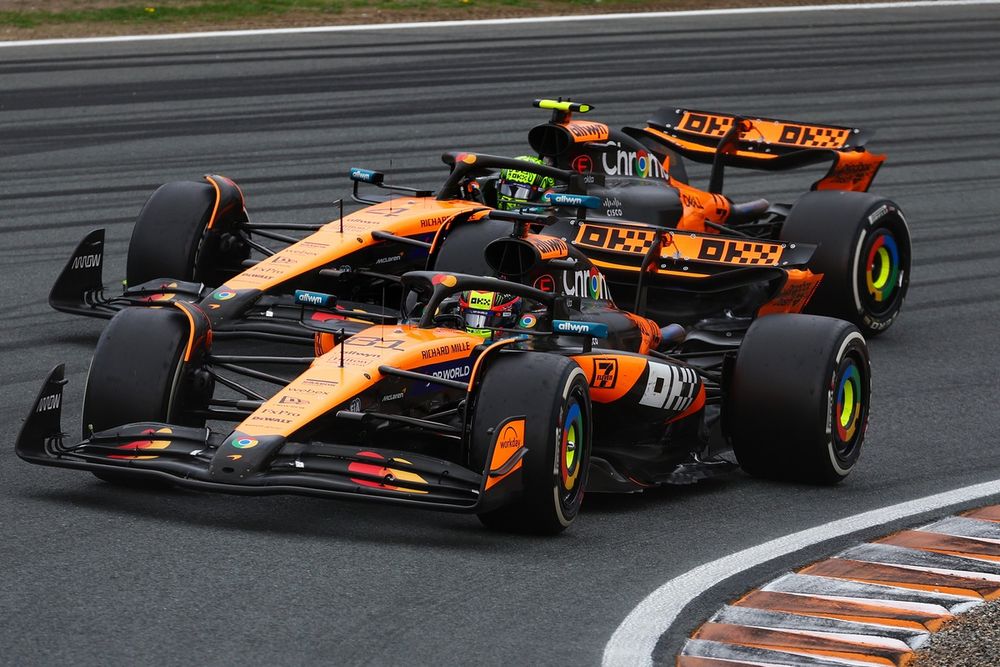“Lando Norris’s title campaign just got a little trickier. His DNF at Zandvoort effectively burns his only ‘joker’ for the second half of the year, meaning he can’t really afford any more retirements if he wants to beat Oscar Piastri to the title. The Australian boosted his chances with yet another win, but which score will he have to drop at the end of the season?”
This kind of summary may sound odd to today’s Formula 1 fans, but if the world championship had kept its 1970s-style scoring, the Piastri–Norris battle wouldn’t look as bleak for Norris as the current 34-point gap between the two McLaren drivers suggests.
Back in the era when technical retirements were commonplace – and drivers lined up knowing there was a very real chance they wouldn’t see the flag – the system made sense. It was only from 1991 that drivers actually kept all the points they scored across the season in the official classification.
From the early years of the world championship, only a selection of results counted – a driver’s worst scores were dropped. In practice, everyone had ‘jokers’ to burn during the campaign, most of which were swallowed by mechanical DNFs. The logic was to dial down the role of luck and let the fastest driver’s best results decide the title.
In 1950, only the four best results out of seven races counted. Then, it became five or six depending on the calendar. And from 1967, the season was effectively split, with a set number of results counting from the first and second halves of the season. In the 1967 season, each driver’s worst result from both the first and second halves of the year was dropped.

Lando Norris, McLaren, Oscar Piastri, McLaren
Photo by: Joe Portlock / LAT Images via Getty Images
If that approach – with one dropped result per half-season – still applied to today’s 24-race calendar, Norris’s Canadian GP retirement wouldn’t trouble him at all. For Piastri, things would look slightly different: he’d lose two points from Melbourne as his worst early-season result – not decisive, but a nudge.
Zandvoort, though, is the bigger swing.
Under dropped scores, it would still be a blow for Norris, but it would simply be his non-counting result – meaning he couldn’t afford any more DNFs to retain a realistic chance of winning the title. In Piastri’s case, it would mean he couldn’t count his 18 points from Hungary yet, because second place there would be his ‘worst’ score of the second half. Ultimately, under that system, if he were to finish first or second in all remaining races, he would effectively lose those 18 points.
Weird? Definitely. Unnecessarily complicated? Sure. Unfair? Well… that’s at least debatable.
What happened to Norris at Zandvoort can easily prove decisive – and likely will – in a world where a win pays 25 points and a retirement pays zero. Think of Lewis Hamilton in Malaysia 2016: if his engine hadn’t failed, he’d have had a much better shot at beating Nico Rosberg to the title – and, without taking anything away from his former team-mate, he’d have been a worthy champion that year, too.
The fact that McLaren’s only technical retirement this year struck Norris is surely a hard one to accept for the Briton. Yes, F1 is a technical sport. But does the current 34-point gap really reflect the performance delta between him and Piastri? In qualifying it’s often a matter of thousandths. It’s fair to say the Australian has been more consistent and very fast this year; Norris isn’t far off, to say the least.

Ayrton Senna and Alain Prost.
Photo by: Ercole Colombo
In 1980, the system shifted to ‘best 11’ results per year, which did serve its purpose of rewarding outright winning more than relentless second places. But the 1988 season hastened the rule’s demise: Alain Prost scored more points across the year, yet lost the title to Ayrton Senna under the ‘best 11’ rule. As car reliability improved, the luck factor shrank, and the dropped-scores concept was finally shelved.
There’s another factor: complexity. Any formula that excludes a driver’s worst results adds a layer of arithmetic that doesn’t help when you’re trying to bring new fans closer to the sport. In football you learn 3-1-0 scoring at primary school; keeping F1 simple matters too. There’s no realistic way for that old system to come back.
But would it make today’s title fight fairer? Perhaps, a bit. Right now, Norris has to compensate heavily for bad luck – and you wouldn’t expect a tennis player to start a set down because of something outside their control.
Then again, F1 is, by design, different. The technical element – even when it feels unfair – is part of the spectacle and a challenge.
The points-scoring system is an interesting point of debate – and it’s always an entertaining exercise to try to apply different systems to historical results to see how much would have changed.
But, ultimately, a sports championship doesn’t exist to identify the single ‘strongest’ athlete in the abstract; it exists to determine a winner under predefined rules. Those aren’t always the same thing.
In this article
Be the first to know and subscribe for real-time news email updates on these topics

